The songbird of the northeast, Mizoram is an adorning state glamoured with scenic spots and vibrant cultural entity. Based mainly on the tribal communities inhabiting this alluring state, referred to as the Mizos, the cultural boundary of Mizoram is reflective in its own way. Known as the land of diverse tribes and races of people living together, the different tribes and communities here have unique features of their own. Mizoram's culture is also reflective of the traditional heritage of the inhabitants. The residents of this peace paying land are very proud of their cultural legacy and go beyond lengths to preserve it in spite of many foreign intrusions. Being the songbird of the northeast, Mizoram perches on the hills, displaying its storehouse of endless natural beauty.
The Mizoram cuisine is reflective of a rich cuisine and focuses mainly on non-vegetarian dishes served on banana leaves. Mustard oil is used for food preparations along with the use of spices like garlic, ginger and chilli. Their food is less spicy as compared to other regions. Rice remains a staple of their diet, with several vegetarian and non-vegetarian curries. Bamboo shoots are used to give the dishes the aroma. Some of the traditional Mizo cuisines include Bai, Vawksa Rep, and Arsa Buhchiar.
Rice is the staple food of the Mizo's. They are primarily both vegetarians and non vegetarians. Fish is one of the most popular food of the people of Mizoram. The Mizo's are fond of dishes made of delicacies like bamboo shoots and ducks. Other favorite dishes include Misa Mach Poora, Panch Phoron Taarkari, which is actually a grilled preparation ofshrimps, Dal with Eggs, Poora Mach and Koat Pitha.The Mizo's avoid oily food. Mustard oil is the most common oil used in cooking.
. 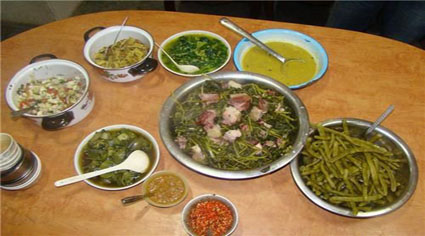
|
|
The Mizo people are known for their intricate designing which can be done only in their looms and they generally known as born weavers. The mottos and patterns used by the Mizo people in their designing has become a part of their cultural heritage and it is passed on to generations. Puan is one of their traditional garment which is used both by the men and women more or less in the same manner and each work involved in designing these garments has a story to tell. These traditional hand woven apparels are of different shades and designs without exquisite play of colour combination and intricate weaving patterns has been evolved. Some of their traditional attires includes Puanchei which is very colourful and is used by every Mizo lady. The ladies of the Mizo community use Kawrchei which is a unique distinctive blouse. Ngotekherh is a traditional cloth used by the men to tie around their waist, but however now it is also used by the women.Cyhna Hno is another embroidered silk puan of the Mara's used by both men and women.
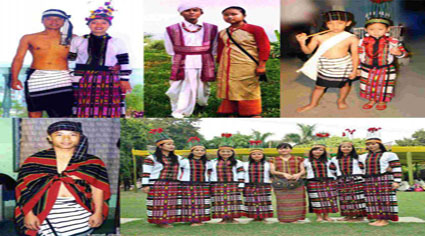
|
|
Music is an indispensable part of the culture of the people of Mizoram. There are a lot of traditionalfolk songs of the Mizo's and they are named after various factors like Tribes, Invocation and Incantation, individuals and modulation of the voice. All these folk songs are accompanied with musical instruments like String instruments which include Tingtang, Lemlawi and Tuiumdar. Some of the beating instruments are Talhkhuang, Khuang, Dar, Bengbung and Seki. They also use wind instruments like Hnahtum, Mautawtawrawl, Rawchhem, Tumphit, Phenglawng and Buhchangkuang.
The Mizo people are known for their traditionalfolk dance which varies from one community to another. Cheaw Dance or the bamboo dance is the most famous dance of the Mizo people where they use the bamboo as the prop and dance according to rhythm. Khuallam dance is performed in groups mainly to welcome guests and the people are dressed in colorful attires during the performance. The Chheih Lam is a unique type of dance which is done over rice beer where the people form a round shape.
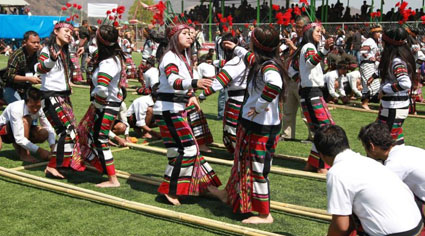
|
|
The Mizo population consists of several ethnic groups. The diversity of these ethnic groups reflect the historical immigration patterns. The majority of the Mizos are Christians. There are four major kinds of tribes in Mizoram, which are the Chakma Tribes, Pawi tribes, Ralte tribes and the Kuki tribes. The tribes of Mizoram are populous, literate, gorgeous, and wish to live free. They reflect a friendly and a happy go lucky personality. The state which is equipped with a plethora of beautiful sites also has many festivals to celebrate. The festivals exhibit the vast cultural diversity of the state. The festival season is the season of harvest. The festivals are celebrated with great vigour and enthusiasm. Festivals thus play a major role in shaping the brotherhood bonds of the tribes, also helping them to perform their old traditions and rituals while renewing some old bonds and ties. Each tribe has its own festival and rituals.
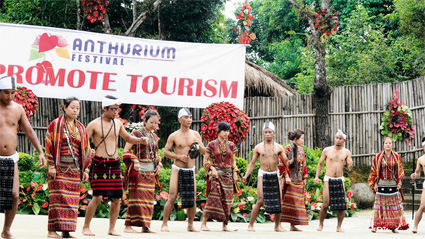
|
|
Mizoram, the land of blue mountains, has a pretty popular wedding trend. It has the most number of inter caste marriage. The Mizo tribes follow the tradition of bride pricing, a custom where payment is made by the groom's side to the bride's kin. Knowing how open minded the Mizos are, the boy and the girl are given an extended courtship period, and then the engagement follows. The boy approaches the girl's family to settle the price. Most of the weddings take place in the church and thus makes Mizo wedding entirely different and unique. One of the interesting traditions followed in a Mizo wedding is that a bride gives a Puandum to the groom which is a traditional rug.
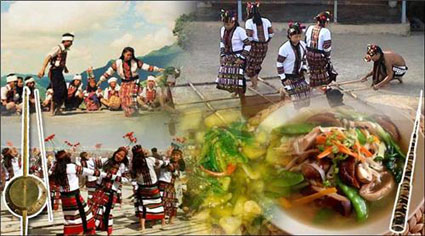
|
|
The Mizo people are known for their handloom and handicraft products which mainly include textiles, bamboo and cane works and basketry. The Mizo ladies are known as born weavers and they produce a wide range of textile products like puanspuon dum, puon pie, thangou puon, puon laisen, jawl puon, thangsuo puon, hmarm and zakuolaisen. Apart from textiles they also excel in items made of bamboos and canes like toys, hats, animal and fish trapscones, baskets, jewelry boxes, utensils, household items and smoking pipes. The smoking pipes are of two types namely the Vaibel and Tuibur pipes where the former made of bamboo is used by the men and the latter made of clay and bamboo is used by the women.
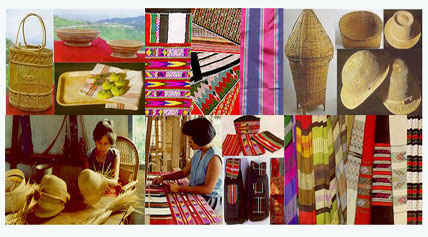
|
|
